Gilding Analysis of the Decorative Paintings of Emperor D. Pedro II's Berlin Device
Nardes, R.C.; Sanches, F.A.C.R.A.; Santos, R.S.; Gama Filho, H.; Freitas, R.P.; Oliveira, D.F.; Assis, J.T.; Zanatta, E.M.; Anjos, M.J.
DOI 10.5433/1679-0375.2023.v44.47985
Citation Semin., Ciênc. Exatas Tecnol. 2023, v. 44: e47985
Abstract:
Emperor D. Pedro II’s berlin device is a very important museological object for the history of Brazil. It was the most imposing imperial vehicle of the entire Brazilian monarchic period, related not only to the image of Emperor D. Pedro II but also to the entire Second Reign. The berlin was commissioned for the coronation ceremony of D. Pedro II in 1841 and belongs to the Imperial Museum collection, located in the city of Petrópolis, Rio de Janeiro, Brazil. In this work, the gold gilding technique used in the decorative paintings of the berlin was analyzed. X-Ray Fluorescence (XRF) and Macro X-Ray Fluorescence (MA-XRF) techniques were applied for gilding analysis. All analyses were performed in situ using portable equipment. XRF measurements performed on the gold leaves revealed the presence of the key element chromium. The combined results of the analytical techniques used indicated the possible use of a mordant containing chromium yellow as an oil-based size to adhere to gold leaves in the decorative paintings. The result found is in line with that described in the literature.
Keywords: archaeometry, gilding, imperial carriage, XRF, MA-XRF, 19\(^{th}\) century
Introduction
In the art of gilding, the main techniques are gold in powder (or shell gold), water gilding (or gouache gilding on bole), and oil gilding (or mordant gilding) (Gulotta et al., 2012). The shell gold applied with tempera was considered to be preferred for tiny details such as illuminated manuscripts or for small painted decorations (Sandu et al., 2011; Mazzinghi et al., 2020).
Water gilding consists of overlaying a layer (traditionally plaster and animal glue) and a clay layer of bole to firmly adhere a pure gold leaf to the base structure (Brocchieri et al., 2022). Oil gilding is the process of using oil-based size (glue) to adhere gold leaf, which is more resistant than to the water-soluble binders used in the water gilding technique (Gulotta et al., 2012; Katsibiri & Boon, 2004). Therefore, oil gilding is the only choice for gilding externally or in damp conditions, and it can provide a durable finish and at the same time a beautiful matte gilded surface coating (Brocchieri et al., 2022; Katsibiri et al., 2002).
For the application of gold on carriages, the mordant gilding technique was recommended by Arlot, 1871 and Burgess, 1881 in their treatises for carriage painters. For the reason that the decorative painting on carriages must resist exposure to moisture, atmospheric changes, and the vibrations to which the vehicle would be subject.
The application of oil-based matte gilding on mordant is the final stage of the embellishing of the painting, where the small pieces of gold leaf are attached to the areas to be adorned using an oil adhesive.
There are many different types of mordants made of various materials, but the standard form consisted of an oleoresinous composition made of linseed oil (or walnut oil) added to ground lead-based pigments, clays, varnishes, and iron oxides. (Katsibiri et al., 2002; Le Gac et al., 2009; Sandu et al., 2011). The most frequently encountered pigments are white lead, red lead, massicot, litharge, verdigris, ochres, and chrome yellow (Brocchieri et al., 2022; Eveno et al., 2014; Katsibiri et al., 2002; Mastrotheodoros et al., 2017; Yang et al., 2022).
Regarding instrumental approaches, it is important that the technological tools chosen for studies developed in the field of Cultural Heritage Science have non-destructive characteristics, as they are unique pieces that have great historical and cultural value.
Therefore, XRF and MA-XRF are techniques widely applied in studies in the art of gilding. The information generated by these techniques can provide a better understanding of an artist’s technique through the elemental characterization of the materials, without causing any damage to the sample. In addition, these analyses make it possible to document previous interventions and the state of preservation of the piece (Brocchieri et al., 2022; Eveno et al., 2014; Maclennan et al., 2019; Mastrotheodoros et al., 2023).
Materials and methods
Artifact analysed
Emperor D. Pedro II’s berlin was ordered for the coronation ceremony of D. Pedro II in 1841, from the English firm Pearce & Countz, which was an English Royal house supplier. The berlin arrived in the state of Rio de Janeiro in 1837 and it was the official vehicle for the exclusive use of D. Pedro II (second and last emperor of the Brazilian monarchy, reigning from 1840 to 1889). Currently, the D. Pedro II’s berlin device (Figure 1 belongs to the Imperial Museum collection, located in the city of Petrópolis, Rio de Janeiro, Brazil.

From Imperial, 1941
The vehicle is 5.10 m in length (without steering wheel), 2.45 m box high (from the ground), and 1.92 m wide. The carriage was richly decorated with the national colors of green and yellow, eight paintings of the Empire’s weapons, sparkling silver ornaments, and ornaments for eight horses equally decorated with silver pieces (Zanatta, 2013).
In all, there are eight paintings, four from the national pavilion and four from the crowned wyverns (symbols depicting the empire). At the superior part of the side flanks, there are also ribbons with stylized phytomorphic elements and golden on a black and light-yellow background.
The aim of this study was to clarify the gold leaf gilding technique used in the decorative paintings of D. Pedro II’s vehicle. To achieve this goal, non-invasive in situ scientific investigations were carried out using the well-established approach based on qualitative analysis obtained by X-Ray Fluorescence (XRF) and Macro X-Ray Fluorescence (MA XRF).
Experimental
For the analysis of the gilding of D. Pedro II’s berlin, the techniques of MA-XRF and XRF were used. Both techniques were performed using portable systems developed at the Laboratory of Electronic Instrumentation and Analytical Techniques (LIETA).
The MA-XRF measurements were carried out using an automated, portable system using a Raspberry Pi microcomputer, which consists of a low-power X-ray tube with a silver target and an SDD detector (Silicon Drift Detector) with an energy resolution of 142 eV at 5.9 keV. The MA-XRF system moves in the XYZ axes, and it is controlled by a microcomputer. Measurements were performed in the XY plane, the Z axis was for focal adjustment (Gamma, 2020).
The mapping of the painting was performed with a voltage of 35 kV, current of 100 \(\mu\)A, collimator diameter of 1 mm, and step size of 2 mm, during a measurement time of 1 s per pixel. The MA-XRF analysis was performed on a 100 by 100 mm matrix in the region of phytomorphic elements on a dark background. The total MA-XRF measurement time was approximately 55 min.
The X-ray Fluorescence spectra were obtained using the portable Energy Dispersive X-ray Fluorescence (ED-XRF) equipment. The portable ED-XRF system used has a low-power X-ray tube with a silver target and an SDD detector (Silicon Drift Detector) with an energy resolution of 122 eV at 5.9 keV. The XRF analyses were carried out at 40 kV, a current of 50 \(\mu\)A, and 180 s of acquisition time.
All the XRF spectra were evaluated using the open-source PyMCA software package (Solé et al., 2007).
Results and discussion
Figure 2 reports the elemental map distribution acquired by the MA-XRF scanning system. This painting represents stylized phytomorphic elements on a black background. The elemental distribution maps show chromium correlated with gold.
(a)
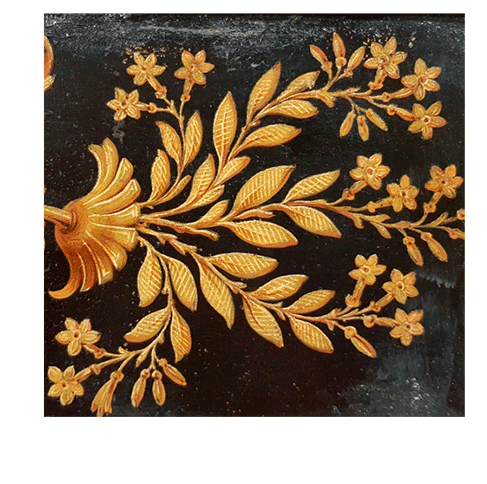
(b)
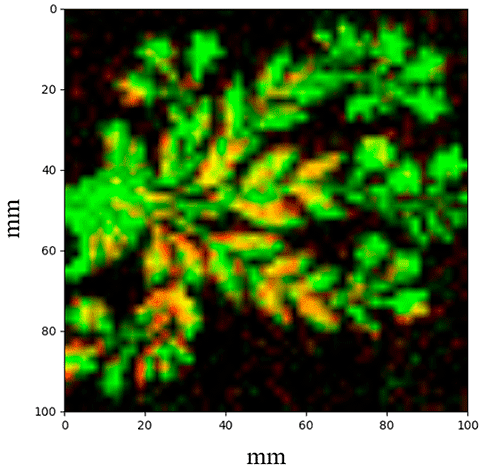
(c)
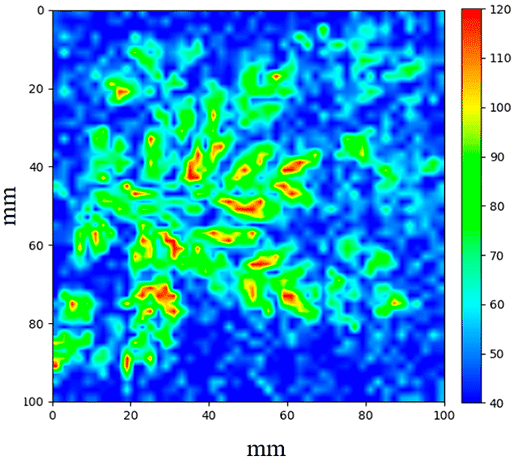
(d)

The drawings of leaves and flowers were made in yellow pigment and the details of leaf veins were made in gold. The MA-XRF information shows the homogeneous distribution of chromium in the drawing of phytomorphic elements. This information suggests that Cr is a key element of the yellow pigment used by the artist in this region of the carriage.
The simultaneous and correlated presence of Au and Cr indicates that chromium and gold are mixed in the upper golden layer.
Figure 3 shows the comparative study on the yellow background of the box and the gold leaf of the national pavilion. The elemental data by ED XRF measurements were collected on the gold leaf of paintings that had no pigment overlay on the gold leaf.
Figure 4 shows the five points selected in this national pavilion that were measured using the ED XRF.
Figure 5 shows the comparison between the XRF spectra of the yellow background of the box and the gold leaf. The XRF spectra allowed identifying the gold gilding and information about the preparation layer.
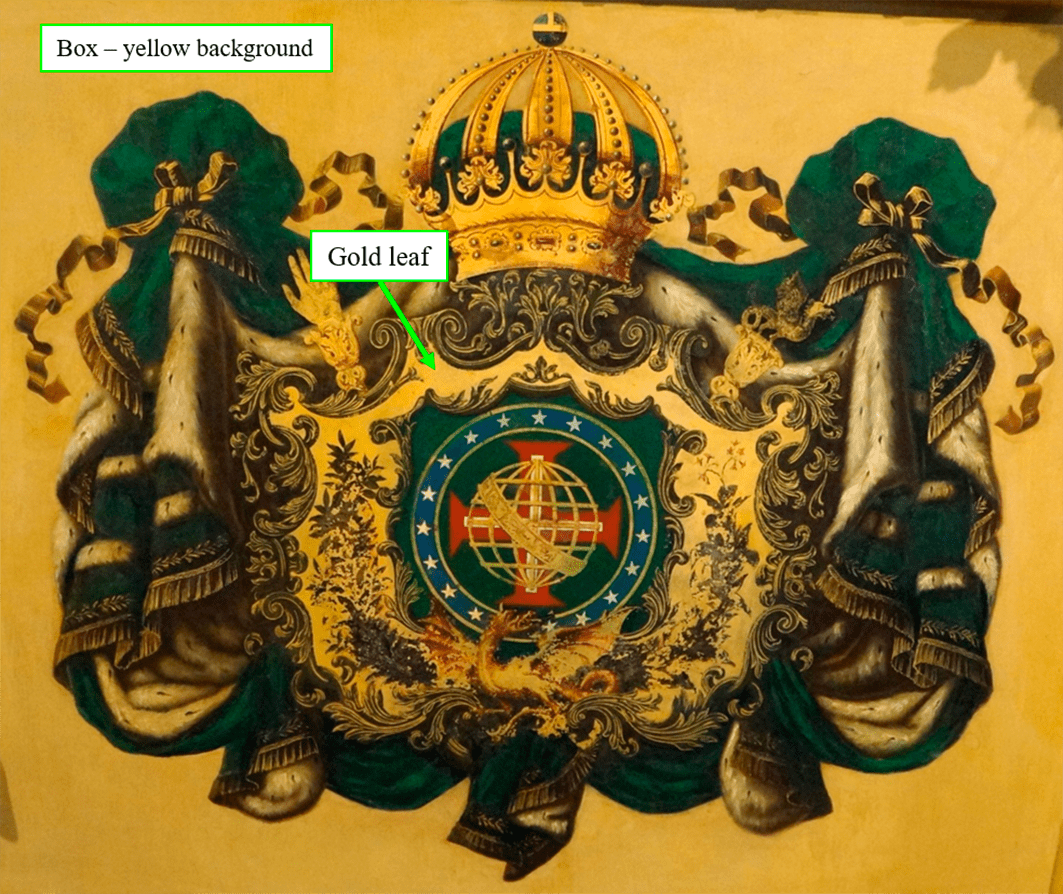

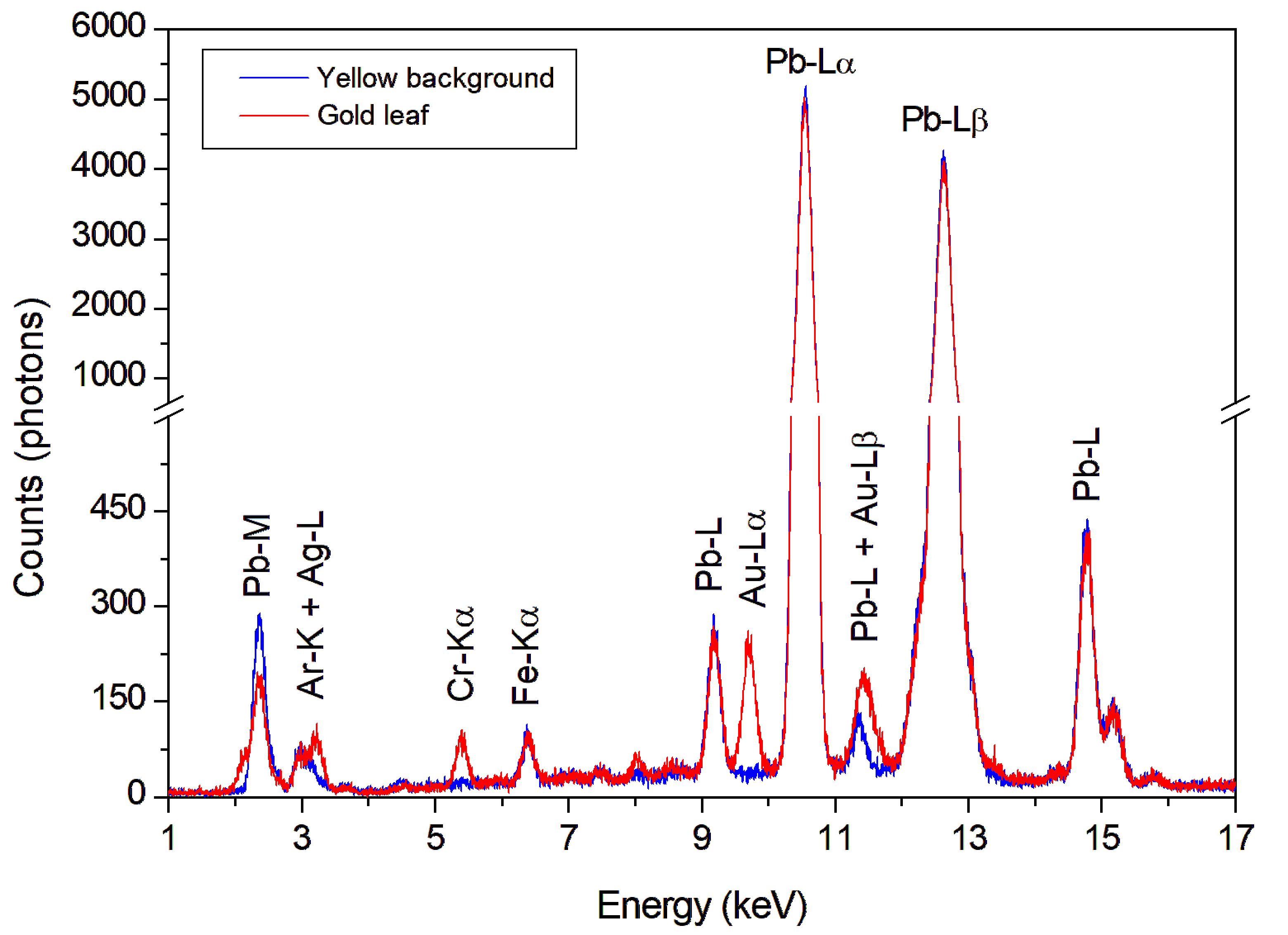
The elements detected by XRF on the gold leaf were chromium (Cr), iron (Fe), gold (Au), and lead (Pb). On the other hand, the elements Fe and Pb were detected in the yellow background of the box. This result suggests that Au and Cr are key elements of gilding.
Table 1 shows the XRF intensities of the elements detected in this analysis. In all XRF spectra, the peaks of the XRF lines of elements Ar (K lines) and Ag (L lines) appear. XRF analyses were not performed in vacuum, and the presence of Ar in the XRF spectrum is the contribution of air (dry air contains about 1.0 % Argon by volume, 1.0 atm, 20°C). The presence of Ag is the contribution of the target of the X-ray tube used in the measurements acquisition.
| Elements | Sample (\(\times 10^3)\) | |
| Gold leaf | Yellow background | |
| Cr | 3.5 \(\pm\) 0.5 | NDa |
| Fe | 3.0\(\pm\) 0.7 | 3.8 \(\pm\) 0.9 |
| Au | 12.0 \(\pm\) 0.7 | ND |
| Pb | 335 \(\pm\) 5 | 362 \(\pm\) 2 |
| aElement not detected. | ||
The presence of Pb is due to the preparation layer made with white lead. In a previous study, it was verified that the entire preparation layer of D. Pedro II’s berlin was made using lead white (Nardes et al., 2019).
The D. Pedro II’s berlin was restored between 2011 and 2013 by the Conservation and Restoration Laboratory of the Imperial Museum, with the support of GE Celma through the Culture Incentive Law (PRONAC). All stages of the treatments were recorded in the technical book (Zanatta, 2013).
The paintings in the external part of the box, referring to the national pavilions and the crowned wyverns, were reintegrated with natural pigments and Paraloid B- 72, using the velatura painting technique. The ultimate protection was with Renaissance wax (Zanatta, 2013).
The XRF spectra show the Fe counts are approximate for both XRF spectra. The analysis suggests that Fe is a signature of the chromatic reintegration process performed by velatura based on Paraloid B-72 and/or Renaissance wax used throughout the external part of the box.
Both elements Cr and Au were detected together in all XRF measurements on gold leaf. The presence of Cr suggests the use of a mordant containing chromium yellow as the adhesive for gold leaf.
In Arlot, 1871 the oil gilding for a carriage was obtained with gold leaf applied over a mixture called house gilders, which consisted of the addition of white lead and chromium yellow finely ground with linseed oil. And the gold leaves were fixed after 12 hours of the application of this mixture.
In Eveno et al., 2014 the use of mordant containing chromium yellow was identified. The authors analyzed the Crucifix made by Giotto (1266 – 1337), belonging to the collection of the Louvre Museum, in Paris, using different spectroscopic techniques. The 14th-century crucifix, 2.84 m high and 2.31 m wide, was restored in the 19th century (same period as D. Pedro II’s carriage).
From micro samples collected during the conservation campaign (Silver, 2014), the original gilding and the one added later in the 19th century to Giotto’s crucifix were characterized. Stratigraphic analysis of gilding carried out in the 19th century revealed the use of orange mordant containing chromium yellow (Eveno et al., 2014).
The study by gilding in the paintings of D. Pedro II’s carriage was carried out in a non-invasive means. Nevertheless, in the XRF and MA-XRF analyses, it was possible to identify the key element Cr. The presence of Cr associated with Au strongly suggests the use of mordant containing chromium yellow as an adhesive for sheet metal. The results obtained in this study agree with the results found in the literature.
The result can be useful for safeguarding and proper restoration of Brazilian cultural heritage.
Conclusion
The combined approach of MA-XRF and XRF used in this study provided information about the materials and techniques used in the gilding of the painting of D. Pedro II’s berlin device.
As demonstrated in this study, MA-XRF allows non-invasive mapping of the distribution of different paint materials with sufficient detail. Cr was identified as a key element of the yellow pigment used as a substrate for the gold leaf in the phytomorphic elements at the superior part of the side flanks.
XRF measurements in the gilding areas of the emperor’s weapons revealed the presence of Au and Cr. The element Cr associated with Au suggests the use of a mordant containing chromium yellow. The result agrees with the literature referring to artifacts from the same period of manufacture of D. Pedro II’s carriage.
Author contributions
R.C. Nardes, F.A.C.R.A. Sanches and R.S. Santos participated in the: Conceptualization, Data Curation, Formal Analysis, Investigation, Methodology, Writing. H. Gama Filho participated in the: Programs. R.P. Freitas, D.F. Oliveira, J.T. Assis and E.M. Zanatta participated in the: Resources M.J. Anjos participated in the: Projects Managements, Supervision, Validation, Visualization.
Conflicts of interest
The authors declare no conflict of interest.
Acknowledgments
This study was financed in part by the Conselho Nacional de Desenvolvimento Científico e Tecnológico (CNPq), the Fundação Carlos Chagas Filho de Amparo à Pesquisa do Estado do Rio de Janeiro (FAPERJ) and Coordenação de Aperfeiçoamento de Pessoal de Nível Superior - Brazil (CAPES) – finance code 001 and Financiadora de Estudos e Projetos (FINEP - CT-INFRA 01.13.0444.02).
References
Arlot, M. (1871).Complete guide for coach painters. Henry Carey Baird. https://archive.org/details/completeguidefor00arlo/page/n6/mode/1up?view=theater&q=colour
Brocchieri, J., Scialla, E., Manzone, A., Graziano, G. O., D’onofrio, A., & Sabbarese, C. (2022). Ananalytical characterization of different gilding techniques on artworks from the Royal Palace (Caserta,Italy).Journal of Cultural Heritage, 57, 213–225. http://dx.doi.org/10.1016/j.culher.2022.08.014
Burgess, J. W. (1881). A practical treatise on coach-building: historical and descriptive.Crosby Lockwood and Co. https://archive.org/details/practicaltreatis00burg/page/n4/mode/1up?view=theaterSemin.
Eveno, M., Ravaud, E., Calligaro, T., Pichon, L., & Laval, E (2014). The Louvre Crucifix by Giotto–Un-veiling the original decoration by 2D-XRF, X-rayradiography,Emissiography,andSEM-EDX analysi. Heritage Science, 2(1), 1–9. https://doi.org/10.1186/s40494-014-0017-y
Gamma, H. S. F (2020).Desenvolvimento de um sistema portátil de macro XRF que utiliza aprendizado de máquina para reconhecimento de padrões de cor e sem pigmentos usados na área de Arqueometria [Thesis PhD, Universidade do Estado do Rio de Janeiro]. Biblioteca Digital de Teses e Dissertações.
Gulotta, D., Goidanich, S., Bertoldi, M., Bortolotto, S., & Toniolo, L.(2012). Gildings and false gildings of the baroque age: characterization and conservation problems. Archaeometry, 54, 940–954. https://doi.org/10.1111/j.1475-4754.2011.00658.x
Imperial Museum. (1941). Berlinda de Aparato (Imperial Family Collection) [Photograph]. http://dami.museuimperial.museus.gov.br/handle/acervo/538
Katsibiri, O., & Boon, J. J. (2004). Investigation of the gilding technique in two post-Byzantine wall paintings using micro-analytical techniques. Spectrochimica Acta Part B: Atomic Spectroscopy, 59 (10-11), 1593–1599. http://dx.doi.org/10.1016/j.sab.2004.07.026
Katsibiri, O., Singer, B., & Devenport, J.(2002). Some aspects of thetechnique and materials used for mordant gilding on Byzantine icons and wall paintings. In R. Van Grieken, K. Janssens, & L. Meersman (Eds.), Art2002 [Proceedings]. 7th International Conference on Non-destructive Testing and Microanalysis for the Diagnostic and Conservation of the Cultural and Environmental Heritage, Antwerp.
Le Gac, A., Seruya, A. I., Lefftz, M., & Alarcão, A. (2009).The main altarpiece of the Old Cathedral of Coimbra (Portugal). Archéosciences, (33), 423–432. 10.4000/archeosciences.2562
Maclennan, D., Llewellyn, L., Delaney, J. K., Dooley, K. A., Patterson, C. S., Szafran, Y., & Trentelman, K.(2019). Visualizing and measuring gold leaf in fourteenth and fifteenth-century Italian gold ground paintings using scanning macro X-rayfluorescence spectroscopy: a new tool for advancing art historical research. Heritage Science, 7(1), 1–9. http://dx.doi.org/10.1186/s40494-019-0271-0
Mastrotheodoros, G. P., Asvestas, A., Gerodimos, T., & Anagnostopoulos, D. F. (2023). Revealingthe Materials, Painting Techniques, and State of Preservation of a Heavily Altered Early 19th Century Greek Icon through MA-XRF. Heritage, 6(2), 1903–1920. http://dx.doi.org/10.3390/heritage6020102
Mastrotheodoros, G. P., Beltsios, K. G., Bassiakos, Y., & Papadopoulou, V. (2017).On the Metal-Leaf Decorations of Post-Byzantine Greek Icons. Archaeometry, 60(2), 269–289. http://dx.doi.org/10.1111/arcm.12287
Mazzinghi, A., Ruberto, C., Castelli, L., Ricciardi, P., Czelusniak, C., Giuntini, L., Mandò, P. A.,Manetti, M., Palla, L., & Taccetti, F. (2020).The importance of being little: MA-XRF on manuscripts on a Venetian island. X-Ray Spectrometry, 50(4), 272–278. http://dx.doi.org/10.1002/xrs.3181
Nardes, R. C., Silva, M., Rezier, A. N., Sanches, F. A. C. R. A., Gama, H. F., Santos, R., Oliveira, D.F., Lopes, R. T., Carvalho, M. L., & Cesareo, R.(2019). Study on Brazilian 18th-century imperial carriage usingx-ray non-destructive techniques. Radiation Physics and Chemistry,154, 74–78. http://dx.doi.org/10.1016/j.radphyschem.2018.04.005
Sandu, I. C. A., Sá, M. H., & Pereira, M. C. (2011). Ancient ‘gilded’ art objects from European cultural heritage: a review on different scales of characterization. Surface and Interface Analysis, 43(8),1134–1151. https://doi.org/10.1002/sia.3740
Silver, N. (2014). Giotto e compagni (musée du Louvre, 18 April-15 July 2013). Catalogue by Dominique Thiébaut, with essays by Donal Cooperand Andrea de Marchi, and contributions by Marianne Besseyere, Thomas Bohl, Sonia Chiodo, Marco Ciatti, Joanna Dunn, Myriam Eveno, Cec. Renaissance Studies, 28(5), 766–776. http://dx.doi.org/10.1111/rest.12044
Solé, V. A., Papillon, E., Cotte, M., Walter, P., & Susini, J. (2007). A multiplatform code for the analysis of energy-dispersive X-ray fluorescence spectra. Spectrochimica Acta Part B:Atomic Spectroscopy, 62, 63–68. https://doi.org/10.1016/j.sab.2006.12.0026
Yang, J., Zhou, Z., Lu, T., & Shen, L. (2022). Investigation of Gold Gilding Materials and Techniques Applied in the Murals of Kizil Grottoes, Xin-jiang, China. Applied Sciences, 12(21), 11202. http://dx.doi.org/10.3390/app122111202
Zanatta, E. M. (2013). Conservation, and restoration: the imperial horse-drawn carriage emperor D.Pedro II. Samaúma.
